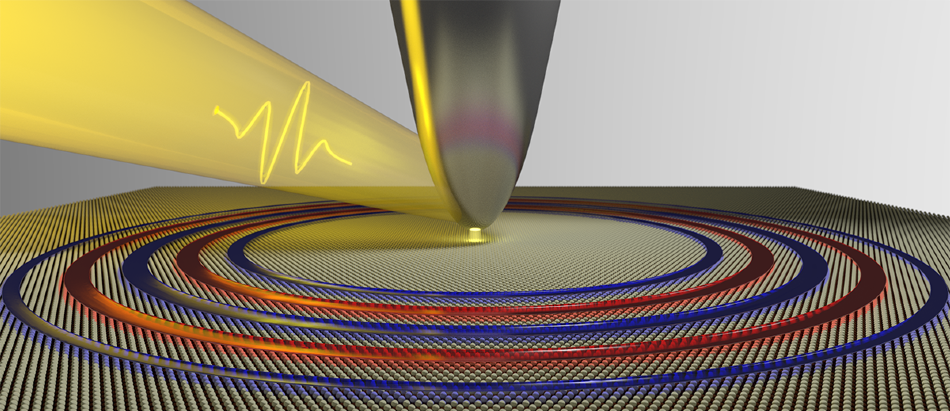May 15 2020
Plasmons, which are wavelike, collective oscillations of electrons, are highly crucial for identifying the optical and electronic properties of metals.
 Illustration of plasmon waves created by an ultrafast laser coupled to an atomic force microscopy tip. The plasmon waves are shown as concentric red and blue rings moving slowly across an atomically thin layer of tantalum disulfide. Image Credit: Felipe da Jornada/Berkeley Lab.
Illustration of plasmon waves created by an ultrafast laser coupled to an atomic force microscopy tip. The plasmon waves are shown as concentric red and blue rings moving slowly across an atomically thin layer of tantalum disulfide. Image Credit: Felipe da Jornada/Berkeley Lab.
When compared to plasmons in bulk metals, plasmons in atomically thin 2D materials possess energy more beneficial for applications such as communication devices and sensors. However, finding out the lifetime of plasmons and whether their energy and other properties can be manipulated at the nanoscale (billionths of a meter) has been elusive.
In a study published in the Nature Communications journal, a research team co-led by the Department of Energy’s Lawrence Berkeley National Laboratory (Berkeley Lab)—with support from the Department of Energy’s Center for Computational Study of Excited-State Phenomena in Energy Materials (C2SEPEM)—has identified long-lived plasmons in a new family of conducting transition metal dichalcogenide (TMD) known as “quasi 2D crystals.”
With the aim of understanding how plasmons function in quasi 2D crystals, the team defined the properties of both conductive and nonconductive electrons in a monolayer of the TMD tantalum disulfide. In earlier studies, only the conducting electrons were analyzed.
We discovered that it was very important to carefully include all the interactions between both types of electrons.
Steven Louie, Study Lead and Director of C2SEPEM, Lawrence Berkeley National Laboratory
Louie is also a professor of physics at UC Berkeley and a senior faculty scientist in the Materials Sciences Division at Berkeley Lab.
The scientists developed new advanced algorithms to estimate the electronic properties of the material, such as plasmon oscillations with long wavelengths, “as this was a bottleneck with previous computational approaches,” stated Felipe da Jornada, lead author of the study and a postdoctoral researcher in the Materials Sciences Division at Berkeley Lab.
At present, Jornada is an assistant professor in materials science and engineering at Stanford University.
The researchers were surprised to observe from the results of the calculations carried out by the Cori supercomputer at Berkeley Lab’s National Energy Research Scientific Computing Center (NERSC) that plasmons in quasi 2D TMDs are quite stable—for nearly about 2 picoseconds, or two-trillionths of a second—than considered earlier.
The study outcomes also indicate that plasmons produced by quasi 2D TMDs could improve the intensity of light by over 10 million times, paving the way for renewable chemistry (chemical reactions triggered by light), or designing electronic materials that can be manipulated by light.
In future studies, the scientists intend to examine ways to tap the highly energetic electrons emitted by such plasmons upon decay, and whether they can be utilized to catalyze chemical reactions.
The authors who contributed to this study are Lede Xian and Angel Rubio of the Max Planck Institute for the Structure and Dynamics of Matter in Hamburg, Germany.
This research was financially supported by the Center for Computational Study of Excited-State Phenomena in Energy Materials (C2SEPEM) and was funded by the U.S. Department of Energy, Office of Basic Energy Sciences. Further support was offered by the National Science Foundation and the European Research Council.
Journal Reference:
Da Jornada, F. H., et al. (2020) Universal slow plasmons and giant field enhancement in atomically thin quasi-two-dimensional metals. Nature Communications. doi.org/10.1038/s41467-020-14826-8.